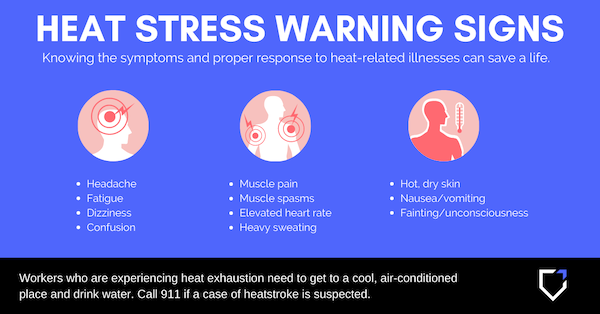Last year was an unprecedented year for extreme heat events. And climate conditions threaten more extreme heat in 2023.
As temperatures rise, so do workplace safety risks. A worker can experience heat stress when they’re exposed to extreme heat for too long and are unable to cool down. Heat stress leads to heat-related injuries and illnesses including heat cramps, heat rash, heat exhaustion, and heat stroke – a medical emergency. If untreated, heat stress can even lead to death.
- An estimated 31,560 work-related heat injuries and illnesses involving days away from work occurred from 2011-2019 (Bureau of Labor Statistics)
- Heat was the second leading cause of weather-related death in 2021 (National Safety Council)
Hot weather workplace safety is an important aspect of occupational health and safety that employers must consider to provide a safe, healthy, hazard-free workplace for their workers.
Who’s at risk?
Research shows outdoor workers in the US have up to 35 times more risk of dying from heat exposure than the general population. And according to the Occupational Safety and Health Administration, agricultural and construction workers are at the highest risk of heat-related injury and illness.
Heat stress, however, can impact all workers exposed to heat. Indoor workers are also at risk in environments without adequate climate control, which is often the case in factories and warehouses.

How to minimize the risk of heat stress
While OSHA has begun to develop new heat-specific safety standards for indoor and outdoor workers, employers can immediately mitigate the risk of heat stress and illness by reducing exposure to heat hazards and implementing heat safety guidelines.
Here are some top hot weather workplace safety tips for employers:
Implement Safe Work Practices
When it comes to working in hot weather, implementing safe work practices is crucial to ensure the well-being and productivity of employees. Here are some measures for employers to consider:
- Adequate Hydration: Workers should be provided with water and encouraged to drink it regularly. Make sure additional water sources are available, and consider offering hydrating snacks and drinks like popsicles, sports drinks, and fruits.
- Rest Breaks: It’s essential to allow workers to take regular breaks to rest and cool down, especially if they’re exposed to outdoor conditions. Encourage them to take rest breaks in shaded areas to help them cool down and recover.
- Shade and Cooling Measures: Provide additional shade options such as tents or canopies to protect workers from direct sunlight. Consider investing in cooling equipment and clothing, such as hard hat cooling inserts and evaporative cooling vests, to help regulate body temperature. Large fans can be utilized to improve air circulation and create a more comfortable working environment.
- Heat Acclimatization Program: Acclimating workers to high heat conditions is crucial. Gradually increase worker exposure to heat over a seven- to 14-day period to help build tolerance and reduce the risk of heat-related illnesses.
- Adapt Work Activities: Schedule work earlier or later in the day when temperatures are cooler, implement work/rest schedules, and explore job rotation to minimize prolonged exposure to heat.
Develop Safety and Emergency Response Plans
Comprehensive safety and emergency response plans can proactively address heat-related risks in the workplace. Here are some important considerations for employers:
- Written Safety Plan: Outline specific measures and protocols to address heat-related safety concerns. Include preventative measures, emergency response procedures, and guidelines for mitigating heat-related risks.
- Supervisor Training: Supervisors play a crucial role in implementing and enforcing safety measures, conducting safety briefs, and effectively managing emergency response protocols. Provide them with comprehensive training on safety planning, specifically focusing on heat safety.
- Additional Safety Briefings: Conduct additional safety briefings specifically related to heat illness prevention. They should highlight the importance of staying hydrated, taking regular breaks, and recognizing the signs and symptoms of heat-related illnesses.
- Heat Illness Prevention Team: Establish a dedicated team responsible for reporting, monitoring, and managing heat-related issues. Include individuals trained in identifying early signs of heat-related illnesses and taking appropriate actions to address them.
- Emergency Response Protocols: Develop clear and actionable emergency response protocols specifically tailored to heat-related emergencies. Include measures for providing immediate medical attention, contacting emergency services, and evacuating the affected area if necessary.
Train Employees on Hot Weather Safety
Thorough training on hot weather safety will give employees a better understanding of how their bodies respond to heat and the potential risks they face. Here are key points to cover:
- Body’s Response to Heat: As temperatures rise, the body’s ability to release heat becomes slower. This can lead to an increase in body temperature, placing additional stress on the body’s cooling mechanisms.
- Impact of Humidity and Stagnant Air: As humidity increases, sweat evaporation decreases, making it more challenging for the body to regulate its temperature. Similarly, stagnant air hinders air circulation, making sweat evaporation even more difficult.
- Mental and Physical Impairment: Even a slight increase in body temperature can significantly impact mental functioning. A 2°F increase can affect concentration, coordination, and decision-making abilities, while a 5°F increase can lead to severe illness or even death.
Monitor Weather & Employees
Employers can take proactive measures to prevent dangerous exposure by monitoring weather conditions. Here’s how to protect workers:
- National Weather Service Heat Index: The NWS Heat Index measures heat-related risk in the workforce. It takes into account both temperature and humidity, providing an indicator of how hot it feels. The higher the Heat Index, the greater the need for protective measures.
- Stay Informed: Pay attention to local news updates and use reliable threat intelligence partners to stay informed about extreme heat alerts and heat-related warnings.
- Ongoing Monitoring: Continuously monitor weather conditions throughout the workday. Be prepared to make adjustments to work activities or provide additional support as necessary.
Have a safe and healthy summer
With summer officially here, and the ongoing threat of high temperatures and extreme heat waves, encourage your clients to take hot weather safety measures seriously. Share these best practices to help employers reduce risk in the workplace and keep workers safe and productive.
